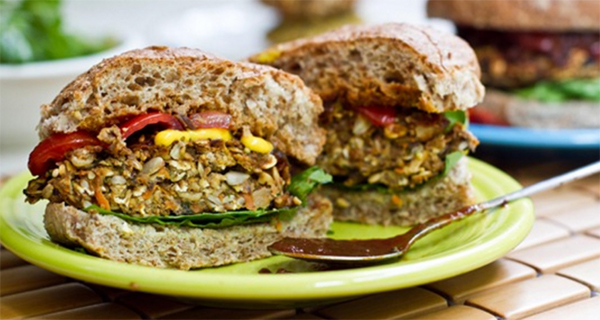
For a long time veggie burger had been a culinary nobody. But when a chef as decorated as Daniel Humm turns his attention to perfecting it, the signal is clear.
Mr. Humm, whose restaurant Eleven Madison Park in Manhattan has three Michelin stars, serves a carefully constructed veggie burger at the NoMad Bar nearby. His version uses grains, fresh vegetables, quinoa and lentils to replace the texture of meat, with eggs, cream cheese and Dijon mustard to hold it together.
After decades as an amateur player eager for a big break, the veggie burger has made its ascent, becoming a destination dish and hashtag darling as never before. The newest generation of veggie burgers has moved from the edges of the menu to its center, a dish to offer not just for the sake of meat-avoiding customers, but to make memorable in its own right. To do that, they are turning to a vast arsenal of ingredients and techniques to get the flavor, texture and heft they’re seeking, as a NY Times report clearly shows.
A MANIFOLD KIND OF BURGER – April Bloomfield created a veggie burger inspired by soondae, a dark Korean blood sausage commonly stuffed with noodles, rice or vegetables, to serve at Salvation Burger. Her version is made with sweet-potato noodles, lentils, carrots, carrot juice and garam masala.
Dan Barber is adding his veggie burger, made with beet and carrot juice pulp, to the rotation on the new bar menu at Blue Hill in Manhattan. Mr. Barber, who first served the burger at his WastED pop-up last year, is now taking the unorthodox step of serving it with a garnish of bacon – actual bacon. “It’s an umami addition, but it does not presume that all veggie burger eaters are vegetarians. Though you can leave off the bacon if you’d like” he says.
Brooks Headley, a former pastry chef at Del Posto, has built an entire restaurant, Superiority Burger, on his veggie burger, which is arguably the most acclaimed burger of any kind in New York in the last few years. His vegan patty is made with fresh vegetables, grains and beans. To bind it together, he uses a potato starch slurry that, when heated to about 180 degrees, “gelatinizes so you’ve got a binding quality that’s similar to using egg”, he said.
THE IMPOSSIBLE BURGER – The recent arrival of the Impossible Burger at Momofuku Nishi in Chelsea has generated a fresh wave of attention for the meatless burger and its possibilities. The animal-free patty, made with a plant-based “meat” developed by the Silicon Valley start-up Impossible Foods, is designed to vividly mimic real beef in taste, texture and bloodiness. Joshua Katcher, a men’s lifestyle writer who is vegan, said eating it was “an emotional experience. I had to sit there and tell myself: This is not a burger” he said.
But while the Impossible Burger is about what high-tech science can do with old-school food, chefs are still working to elevate veggie burgers using the more traditional tools of the kitchen.
JUST MAKE IT SIMPLE – Chloe Coscarelli, the “Cupcake Wars” winner behind the popular vegan By Chloe restaurants in New York, said that even as the bar for vegan food is raised and more people opt to eat meat-free, her veggie burger philosophy remains simple. One of her burgers is made of sweet potatoes, black beans and quinoa, and is topped with guacamole, corn salsa, chipotle aioli and, for texture, crispy tortilla chips.
At Toad Style, a vegan comfort food restaurant in Bedford-Stuyvesant, Brooklyn, the co-chef Jillian Camera said she wasn’t a fan of the “seitan-y, rubbery, fake-tasting thing” of veggie burgers past. Instead, her cheeseburger is made with cremini mushrooms, red onion, green lentils, steel-cut oats, chia seeds, garlic and a variety of spices, then topped with almond cheese. Ms. Camera, who has never tasted a beef burger, has a veggie burger outlook similar to Ms. Coscarelli’s: concentrate on vegetables, grains and “easy-to-understand ingredients in a familiar incarnation.”
Aesthetics matter more than ever in this new veggie burger landscape. John Secretan, the owner of Zinc Cafe & Market, a casual restaurant with three locations in Southern California, hasn’t changed his veggie burger recipe much since it was introduced on the menu some 25 years ago. But after he opened a restaurant in 2014 in the Arts District of Los Angeles, he learned that what many of the city’s young tastemakers wanted wasn’t the more traditional veggie burger preferences of his customers in Orange County. He kept his brown rice, walnut and mushroom patty the same, but changed its accouterments, adding melted cheese, braised onions and sautéed mushrooms.
The goal was to maintain quality while creating that juicy, visceral experience his new customers craved.
Even diners in a meat-and-potatoes town like Cleveland have an appetite for a top-notch veggie burger. Erik Roth, the chef at TownHall, said his customers expect a moist patty that’s “crisp on the outside, soft in the middle, like a medium-rare burger.” His recipe marries roasted beets, brown rice and black beans, with optional white Cheddar on top. Most important, he said, there’s no room for error. “Vegans are detail-oriented, so if you mess up, you’re done,” he said.
